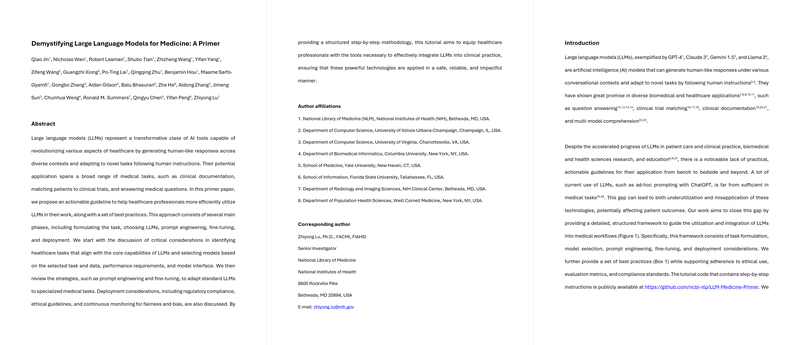LLMs in Medicine: Structured Implementation Strategies
The paper, "Demystifying LLMs for Medicine: A Primer," offers a comprehensive overview of how LLMs can be strategically implemented in healthcare settings. This detailed guide aims to fill a critical gap in actionable methodologies for healthcare professionals aiming to harness the capabilities of LLMs in clinical practice.
Core Framework and Methodology
The authors propose a systematic framework comprising task formulation, model selection, prompt engineering, fine-tuning, and deployment considerations. This structure is poised to maximize the utility of LLMs in tasks including clinical documentation, patient-trial matching, and medical question answering, among others. Each phase of this methodology is meticulously outlined to ensure regulatory compliance, ethical use, and optimal performance.
Task Formulation
A key initial step involves identifying healthcare tasks that align with LLM capabilities, categorized into five primary types: knowledge and reasoning, summarization, translation, structurization, and multi-modal data analysis. Collecting approximately 100 diverse test cases is recommended for evaluation, reflecting a robust empirical approach to task assessment.
Model Selection and Considerations
Selecting an appropriate LLM is contingent upon factors such as task characteristics, performance requirements, and model interface. The paper highlights various LLMs, both proprietary (e.g., GPT-4, Claude) and open-source (e.g., Llama), recognizing the trade-offs between model size, capability, and compliance. Notably, larger models typically offer enhanced performance, but at the cost of increased resource demand.
Prompt Engineering and Fine-Tuning
Effective utilization of LLMs requires careful prompt design. Techniques like few-shot learning, chain-of-thought prompting, and retrieval-augmented generation are expounded upon to enhance task-specific performance. Where prompt engineering alone does not suffice, fine-tuning — either full or parameter-efficient methods — is discussed, particularly in cases where training data is abundant.
Deployment and Ethical Considerations
Deployment is addressed with an emphasis on legal compliance, particularly concerning patient data privacy. The importance of safeguarding against biases and ensuring equity is underscored, as is ongoing monitoring post-deployment. The cost implications of both proprietary and open-source deployment models are thoughtfully considered, recognizing the diversity in operational contexts.
Implications and Future Directions
The primer not only provides a practical guide for using LLMs in medicine but also sets the groundwork for future research and implementation practices. As the capabilities and applications of AI in healthcare continue to evolve, this framework offers a pivotal reference for integrating LLMs responsibly and effectively.
In conclusion, the paper lays a foundational framework that addresses technical, ethical, and operational dimensions of deploying LLMs in clinical practice. Its structured approach facilitates the leveraging of LLMs' capabilities to enhance healthcare delivery, contingent on adherence to established best practices and ongoing evaluative oversight.
